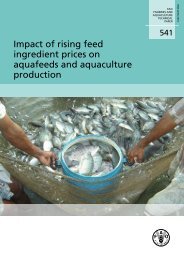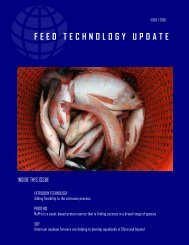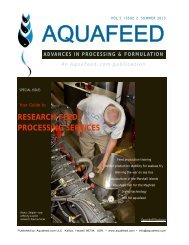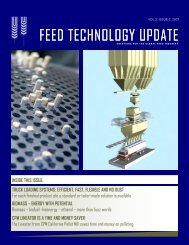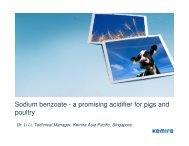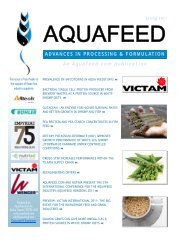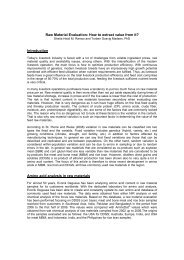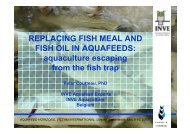The Role Of Meat And Bone Meal In - AquaFeed.com
The Role Of Meat And Bone Meal In - AquaFeed.com
The Role Of Meat And Bone Meal In - AquaFeed.com
Create successful ePaper yourself
Turn your PDF publications into a flip-book with our unique Google optimized e-Paper software.
<strong>The</strong> <strong>Role</strong> of <strong>Meat</strong> and <strong>Bone</strong><br />
<strong>Meal</strong> in Diets for<br />
Monogastric Animals and<br />
Aqua species<br />
Kenneth I. Bruerton Ph.D.<br />
Protea Park Nutrition Services<br />
Gold Coast, Qld, Australia
OVERVIEW<br />
‣ Rendered products are used widely in<br />
Australia in monogastric diets<br />
• Poultry: Broiler, Layer (breeder and table egg)<br />
• Swine: all ages including breeding pigs<br />
• Pet: dog and cat<br />
• Aquaculture - fish<br />
• Diets for all these animals use meat and bone<br />
meal, blood meal and tallow.
Advantages of <strong>Meat</strong> and <strong>Bone</strong> <strong>Meal</strong><br />
‣ Traditional Advantages:<br />
• High Protein<br />
• Reasonable source of digestible amino acids<br />
• Good source of macro minerals – Ca, P.<br />
• Freedom from mycotoxins<br />
‣ Recently Recognized Advantages:<br />
• Carnitine<br />
• Creatine<br />
• Conjugated linoleic acid
<strong>Meat</strong> and <strong>Bone</strong> <strong>Meal</strong> as a Protein<br />
Source<br />
‣ Only soybean meal surpasses MBM as a source<br />
of amino acids relative to its crude protein level.<br />
‣ <strong>Meat</strong> and bone meal <strong>com</strong>plements soybean<br />
meal very well in pig and poultry diets<br />
‣ Protein meals are evaluated according to:<br />
• Total amino acid content<br />
• Digestible amino acid content<br />
‣ Amino acid digestibility is a major determinant of<br />
economic value<br />
‣ Using Regression Equations we can predict<br />
amino acid values from crude protein
Predicting Amino Acid levels<br />
Source: Degussa AminoDat 3.0 Platinum
Mineral content<br />
‣ Adequate supplies of Ca and P are essential for<br />
bone development in all species.<br />
‣ A traditional advantage of MBM is that it is an<br />
important and bioavailable source of Ca and P.<br />
‣ <strong>Meat</strong> and bone meal also contributes significant<br />
amounts of Na (0.7%), Cl (0.65)% and Mg<br />
(1.1%).<br />
‣ <strong>Meat</strong> and bone meal is a good source of Fe,<br />
Typical levels are about 600 mg/kg.<br />
‣ <strong>Meat</strong> and bone meal contains about 70 mg/kg of<br />
Zn.
Macro-mineral content<br />
‣ Van Barneveld et al (1994) showed that<br />
Ca = Ash X 0.37<br />
P = Ash X 0.18<br />
Ca : P = 2 : 1<br />
‣ Very high correlation between ash and Ca and P<br />
(0.9)<br />
‣ Ash is a very reliable guide to Ca and P content<br />
of MBM<br />
‣ Ash is a much easier and cheaper assay
Functional Nutrients<br />
‣ Carnitine – important for fertility in all species.<br />
• meat and bone meal is a good source and contains<br />
10-20 times the level in soybean meal.<br />
‣ Creatine – important for energy release in<br />
muscles.<br />
• Although all animals can synthesize creatine the<br />
stress of high production often means that young<br />
animals cannot synthesize enough.<br />
• <strong>Meat</strong> and bone meal contains significant amounts of<br />
creatine.<br />
‣ Conjugated linoleic acid (CLA) – involved in the<br />
immune response and in carcass quality<br />
• <strong>Meat</strong> and bone meal is a natural source of CLA.
Poultry
Amino Acid Digestibility of <strong>Meat</strong> and <strong>Bone</strong> <strong>Meal</strong> in<br />
Poultry<br />
Australian MBM Technical Review – <strong>Meat</strong> and Livestock Australia (2003)
Energy Values of <strong>Meat</strong> and <strong>Bone</strong><br />
‣Poultry<br />
<strong>Meal</strong><br />
• TME Broilers: 2450 kcal/kg (Dale<br />
1997)<br />
and Parsons 1998)<br />
2536 kcal/kg (Wang<br />
Re<strong>com</strong>mended: 2500 kcal/kg<br />
(broilers),<br />
2700/kcal/kg (layers)<br />
{Australian MBM Technical Review – <strong>Meat</strong> and Livestock<br />
Australia (2003)}
Bioavailability of P<br />
‣ A very thorough study <strong>com</strong>paring the<br />
bioavailability of meat and bone meal for<br />
promoting bone growth in broilers<br />
concluded that there was no significant<br />
difference from that of monodicalcium<br />
phosphate. (Waldroup, P.W. and M.H. Adams, 1994.<br />
Evaluation of the phosphorus provided by animal<br />
proteins in the diet of broiler chickens. J. Appl. Poult.<br />
Res., 3: 209-216.)<br />
‣ <strong>In</strong> practical terms Bioavialability of P can<br />
be considered 100%.
Pigs
Amino Acid Digestibility of <strong>Meat</strong> and <strong>Bone</strong> <strong>Meal</strong> in<br />
Pigs<br />
Australian MBM Technical Review – <strong>Meat</strong> and Livestock Australia (2003)
Energy Values of <strong>Meat</strong> and <strong>Bone</strong><br />
<strong>Meal</strong><br />
‣Pigs<br />
DE: 12.1 mj/kg (Edwards<br />
•<br />
1995)<br />
ME: 2225 kcal/kg (NRC<br />
•<br />
1998)<br />
{Australian MBM Technical Review – <strong>Meat</strong> and<br />
Livestock Australia (2003)}
Bioavailability of P<br />
‣ Various studies done over the years but<br />
recent studies suggest that bioavailability<br />
is high and can be considered as 90-100%<br />
for practical formulation purposes.<br />
S. L. Traylor, G. L. Cromwell and M. D. Lindemann Bioavailability<br />
of phosphorus in meat and bone meal for swine. J Anim Sci<br />
2005. 83:1054-1061.
Companion Animals
Companion Animals<br />
‣ <strong>Meat</strong> and bone meal was once widely used in<br />
pet foods in the US but is not as popular today.<br />
‣ This is not for nutritional reasons and is perhaps<br />
more to do with perceived consumer choices.<br />
‣ Digestibility of meat and bone meal has been<br />
shown to be <strong>com</strong>parable to other popular pet<br />
food ingredients such as poultry meal and lamb<br />
meal (Johnson et al, 1998. J. Anim. Sci.76:1112–1122.)<br />
‣ According to Dr Greg Aldrich (Petfood <strong>In</strong>dustry<br />
Magazine, January 2005) it has been underestimated<br />
by US pet food manufacturers.
Aquaculture
Aquaculture<br />
Commodity prices 2005-2010<br />
Hammersmith Commodity prices: http://hammersmithltd.blogspot.<strong>com</strong>/<br />
2500<br />
2000<br />
Hammersmith Commodity prices: http://hammersmithltd.blogspot.<strong>com</strong>/<br />
US$/t<br />
1500<br />
1000<br />
500<br />
2100<br />
1600<br />
1100<br />
600<br />
100<br />
0<br />
Commodity Prices 2005 - 2008<br />
Fishmeal FAQ 65 CP<br />
Soybean 48 CP<br />
Feather meal 80 CP<br />
Crude fish oil<br />
<strong>Meat</strong> & <strong>Bone</strong> meal<br />
Poultry meal 57 CP
Aquaculture<br />
‣ <strong>The</strong> high cost of fish meal has caused a<br />
change in thinking about how diets for<br />
aquaculture species are constructed.<br />
‣ Replacing just 20% of the fish meal in a<br />
diet with meat and bone meal can save at<br />
least US$200/tonne.<br />
‣ This incentive has resulted in a large body<br />
of research into the use of alternative<br />
ingredients in aquafeeds.
Aquaculture<br />
‣ Can meat and bone meal replace fish meal in aquaculture<br />
diets<br />
‣ Digestibility<br />
• First step in evaluating any ingredient<br />
• Gross & digestible value can be improved or reduced by<br />
processing & inclusion level<br />
‣ Utilisation<br />
• Estimate maximum content that can be used without<br />
affecting weight gain, growth, feed intake, FCR, immune<br />
status, etc<br />
‣ To replace fishmeal & fish oil need to better understand<br />
requirements<br />
• Protein and amino acids (in relation to digestible energy)<br />
• Total lipid and EFA<br />
• Micronutrients
Aquaculture<br />
‣ Experiments have been conducted in many species of farmed fish<br />
replacing fish meal with meat and bone meal.<br />
‣ Over a number studies 30-50% replacement has resulted in no<br />
change in performance. (carp – Yang et al, 2004; yellow croaker –<br />
Ai et al, 2006)<br />
‣ For some species, studies have shown it is possible for 100%<br />
replacement (trout – Yu Yu 2008; tilapia – Rodrigues et al, 1996) .<br />
‣ <strong>In</strong> shrimp L. vannamei, Cruz-Saurez et al, (2007) showed that up to<br />
80% replacement of fish meal with poultry meal had no effect on<br />
growth<br />
‣ <strong>In</strong> shrimp L. vannamei up to 60% replacement of fish meal with meat<br />
and bone meal showed no effect on growth (Zhu et al, 2004)<br />
‣ This represents a major saving in diet cost
Disadvantages of <strong>Meat</strong> and <strong>Bone</strong> <strong>Meal</strong><br />
‣ Variability – there are many sources and types in<br />
the market.<br />
• <strong>The</strong> industry takes a lot of care to assess the quality<br />
of different sources<br />
‣ Biogenic Amines – the end products of bacterial<br />
degradation of muscle protein.<br />
• Extensive testing of sources by poultry <strong>com</strong>panies<br />
revealed that high levels result from offal left for<br />
longer times before rendering<br />
‣ Salmonella – present in meat and bone meal.<br />
• Pelleting drastically reduces levels<br />
• Testing by customers and <strong>com</strong>munication with<br />
suppliers has proved to be the best way to reduce<br />
levels in meat and bone meals
Summary<br />
‣ <strong>Meat</strong> and bone meal is a a valuable<br />
formulation tool for nutritionists to lower<br />
feed costs.<br />
‣ It offers cost effective, bioavailable<br />
sources of amino acids,minerals and<br />
energy for pigs, poultry, <strong>com</strong>panion<br />
animals and aquaculture species.<br />
‣ <strong>Meat</strong> and bone meal from Australia and<br />
NZ has the added benefit of being free<br />
from BSE.



